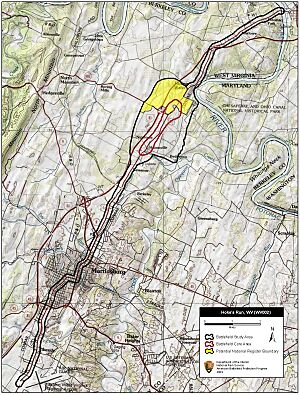Battle of Hoke's Run facts for kids
Quick facts for kids Battle of Hoke's Run |
|||||||
|---|---|---|---|---|---|---|---|
| Part of the American Civil War | |||||||
 Colonel John C. Starkweather with his Wisconsin regiment |
|||||||
|
|||||||
| Belligerents | |||||||
| Commanders and leaders | |||||||
| Robert Patterson | Stonewall Jackson | ||||||
| Units involved | |||||||
| Army of the Shenandoah | Jackson's Brigade | ||||||
| Strength | |||||||
| 8,000 (2 brigades) |
4,000 (1 brigade) |
||||||
| Casualties and losses | |||||||
| 23 | 91 | ||||||
The Battle of Hoke's Run was an early fight in the American Civil War. It happened on July 2, 1861, in what is now West Virginia. This battle is also known as the Battle of Falling Waters or Hainesville.
It was an important early test for Confederate Colonel Thomas J. Jackson and his soldiers. This small battle took place just 19 days before Jackson earned his famous nickname. Both sides learned important lessons from this brief fight. Jackson's forces followed orders to slowly pull back against a larger Union army. They resisted General Robert Patterson's Union troops for a while, then slowly retreated over several miles.
Contents
The Battle Begins
On July 2, 1861, Union Major General Robert Patterson's army crossed the Potomac River. They marched from Williamsport, Maryland, towards Martinsburg.
Near a place called Hoke's Run, Union soldiers met Confederate troops. These Confederates were part of Colonel Thomas J. Jackson's brigade. The Union brigades were led by Colonels John J. Abercrombie and George H. Thomas.
Jackson's job was to slow down the Union advance. His smaller force fought well, holding back the Union soldiers. Then, as planned, Jackson's troops slowly pulled back. This allowed them to escape Patterson's much larger army.
Confederate Forces at Hoke's Run
The Confederate forces were part of the Army of the Shenandoah. This army was led by Brigadier General Joseph E. Johnston.
Colonel Thomas J. Jackson commanded the First Brigade. His brigade included:
- The 2nd, 4th, and 5th Virginia Infantry regiments.
- The 1st Rockbridge Artillery, which used cannons.
- Cavalry led by Lieutenant Colonel J.E.B. Stuart, who rode horses.
Who Won and Who Lost?
It's a bit tricky to know the exact number of soldiers hurt or captured. Different reports give different numbers.
The National Park Service says the Union had 23 casualties. They report 91 Confederate casualties. Other sources have different numbers. For example, one report says 75 Union deaths and 25 Confederate deaths.
General Robert Patterson said over 60 Confederates died. He did not say how many Union soldiers were hurt. One Confederate battle flag was captured by the First Wisconsin regiment.
Here are some of the reported losses for the Union side:
- First Wisconsin Infantry: 1 killed, 5 wounded, 1 captured.
- Eleventh Pennsylvania Infantry: 1 killed, 10 wounded.
- Fifteenth Pennsylvania Infantry: 1 wounded, 35 captured. Six of these captured soldiers later died in Confederate prisons.
- Other units also had a few soldiers captured or wounded.
In total, Union forces had about 3 killed, 17 wounded, and 50 captured.
For the Confederate side, the numbers are not complete:
- 1st Virginia Cavalry: 2 killed and 1 wounded.
- 5th Virginia Infantry: 9 killed and 11 wounded.
- The 2nd Virginia Infantry had no known report of casualties.
So, the known Confederate casualties were at least 11 killed and 12 wounded.
What Happened Next?
After the battle, on July 3, General Patterson's Union army moved into Martinsburg. But he did not push forward much more. On July 15, he marched to Bunker Hill.
Instead of going to Winchester, Patterson turned east. He went to Charles Town and then pulled back to Harpers Ferry.
Patterson's decision to pull back was very important. It took pressure off the Confederate forces in the Shenandoah Valley. This allowed Confederate General Joseph E. Johnston to move his army. Johnston's troops went to help General P.G.T. Beauregard at Manassas Junction.
This help was crucial for the Confederates. On July 21, the Union army suffered a big defeat at the First Battle of Bull Run. After this major battle, General Robert Patterson was blamed for the Union loss. Meanwhile, Colonel Thomas J. Jackson became famous for his actions in that battle.


